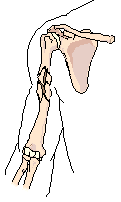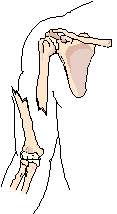Types of Injuries
Fractures - A fracture is defined as a break in the bone.
Dislocation - Displacement of a body part, especially the temporary displacement of a bone from its normal position.
Strain - A strain is an injury to either a muscle or a tendon (fibrous cords of tissue that connect muscle to bone).
Sprain - A sprain can result from a fall, a sudden twist, or a blow to the body that forces a joint out of its normal position and stretches or tears the ligament supporting that joint.
Types of Fracture

Green stick fracture: It is the fracture in the young bone of children where the break is incomplete, leaving one cortex intact .

Closed fracture: A closed fracture is one where the fracture does not communicate with the outside.

Open fracture: (Compound fracture) This is one where the fracture communicates with the outside through an open wound. A compound fracture is a serious injury as infection may gain entrance into the body through the wound and thereby endanger the limb or even life.
Pathological fracture: It is a fracture occurring after a trivial violence in a bone weakened by some pathological lesion. This lesion may be a localised one, like a secondary malignant deposit or a generalised disorder like osteoporosis.
Mechanism
A fracture can be caused by either by direct violence or indirect violence. Direct violence causes a fracture at the site if impact of the force. Indirect violence is one that is transmitted to a bone away from the site of impact producing fracture there.
Signs and Symptoms
- Pain in the injured area
- Swelling in the injured area
- Deformity in the injured area
- Difficulty using or moving the injured area in a normal manner
- Bruising, or redness in the injured area
- Crepitus
- Tenderness
Dislocation
A dislocation occurs when extreme force is put on a ligament, allowing the ends of two connected bones to separate. The mechanism is the same as a fracture.
Signs and Symptoms
- Pain in the injured area
- Swelling in the injured area
- Deformity in the injured area
- Fixation of a joint
- Bruising, or redness in the injured area
- Tenderness
Sprain
A sprain is an injury to a ligament. Ligaments are thick, tough, fibrous tissue that connects bones together. The ligaments can be injured by being stretched too far from their normal position. However, when too much force is applied to a ligament, such as in a fall, the ligaments can be stretched or torn; this injury is called a sprain.
Strain
A strain is an injury to a muscle or tendon. Muscles move your skeleton in a variety of ways. When a muscle contracts it pulls on a tendon, which is in turn connected to your bone. Muscles are made to stretch, but if stretched too far, or if stretched while contracting, a strain my result. A strain is stretching or tear of the muscle or tendon.
Signs and Symptoms
- Pain in the injured area
- Swelling in the injured area
- Bruising, or redness in the injured area
- Tenderness
As with all the injuries listed above one thing stands out, this is the fact that all the signs and symptoms are very similar. This makes it extremely difficult to diagnose what type of injury has occurred. Because of this difficulty the management of all the listed injuries is to treat as a fracture until an X-Ray can prove or disprove a break.
Management
Reassurance, Entonox for pain relief, Stop any haemorrhaging, Immobilise the affected area above and below
injury, check for circulation of affected part, feel for
distal pulses and for sensory loss numbness or
pins and needles if there is any major deficit in
circulation or sensory then the fracture will need to be
reduced to near as normal, remove any tight clothing or
jewellery before limb swelling occurs, apply ice or a cool pack to the affected part to help reduce swelling. Continually monitor the patients condition
ASHICE (consider)
Transport to Hospital
Professional Handover